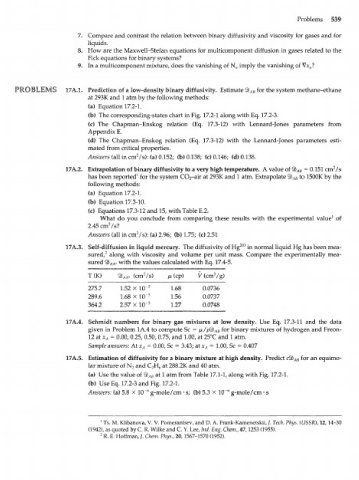Page 559 - Bird R.B. Transport phenomena
P. 559
Problems 539
7. Compare and contrast the relation between binary diffusivity and viscosity for gases and for
liquids.
8. How are the Maxwell-Stefan equations for multicomponent diffusion in gases related to the
Fick equations for binary systems?
9. In a multicomponent mixture, does the vanishing of N a imply the vanishing of Vx ?
a
17A.1. Prediction of a low-density binary diffusivity. Estimate ЯЬ for the system methane-ethane
АВ
at 293K and 1 atm by the following methods:
(a) Equation 17.2-1.
(b) The corresponding-states chart in Fig. 17.2-1 along with Eq. 17.2-3.
(c) The Chapman-Enskog relation (Eq. 17.3-12) with Lennard-Jones parameters from
Appendix E.
(d) The Chapman-Enskog relation (Eq. 17.3-12) with the Lennard-Jones parameters esti-
mated from critical properties.
2
Answers (all in cm /s): (a) 0.152; (b) 0.138; (c) 0.146; (d) 0.138.
17A.2. Extrapolation of binary diffusivity to a very high temperature. A value of ЯЬ = 0.151 cm /s
2
АВ
has been reported 1 for the system CO -air at 293K and 1 atm. Extrapolate ЯЬ to 1500K by the
АВ
2
following methods:
(a) Equation 17.2-1.
(b) Equation 17.3-10.
(c) Equations 17.3-12 and 15, with Table E.2,
What do you conclude from comparing these results with the experimental value 1 of
2.45 cm7s?
2
Answers (all in cm /s): (a) 2.96; (b) 1.75; (c) 2.51
17A.3. Self-diffusion in liquid mercury. The diffusivity of Hg 203 in normal liquid Hg has been mea-
sured, 2 along with viscosity and volume per unit mass. Compare the experimentally mea-
sured Q) * with the values calculated with Eq. 17.4-5.
AA
2
T (K) % * (cm /s) /x (cp) V (crnVg)
AA
275.7 1.52 X 10" 5 1.68 0.0736
289.6 1.68 X 1 0 s 1.56 0.0737
364.2 2.57 X 10" 5 1.27 0.0748
17A.4. Schmidt numbers for binary gas mixtures at low density. Use Eq. 17.3-11 and the data
given in Problem 1A.4 to compute Sc = /л/рЯЬ for binary mixtures of hydrogen and Freon-
АВ
12 at x A = 0.00, 0.25, 0.50, 0.75, and 1.00, at 25°C and 1 atm.
Sample answers: At x A = 0.00, Sc = 3.43; at x A = 1.00, Sc = 0.407
17A.5. Estimation of diffusivity for a binary mixture at high density. Predict сЯЬ АВ for an equimo-
lar mixture of N and C H at 288.2K and 40 atm.
6
2
2
(a) Use the value of 4b at 1 atm from Table 17.1-1, along with Fig. 17.2-1.
AB
(b) Use Eq. 17.2-3 and Fig. 17.2-1.
6
Answers: (a) 5.8 X 10" g-mole/cm • s; (b) 5.3 X 10" g-mole/cm • s
6
1 Ts. M. Klibanova, V. V. Pomerantsev, and D. A. Frank-Kamenetskii, /. Tech. Phys. (USSR), 12,14-30
(1942), as quoted by С R. Wilke and C. Y. Lee, Ind. Eng. Chem., 47,1253 (1955).
2 R. E. Hoffman, /. Chem. Phys., 20,1567-1570 (1952).

